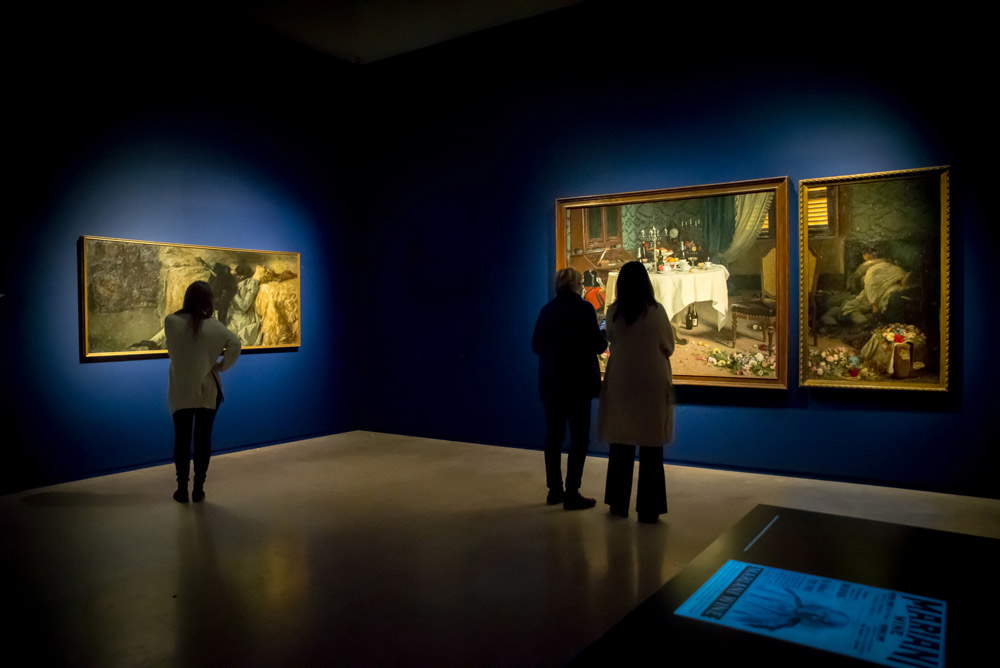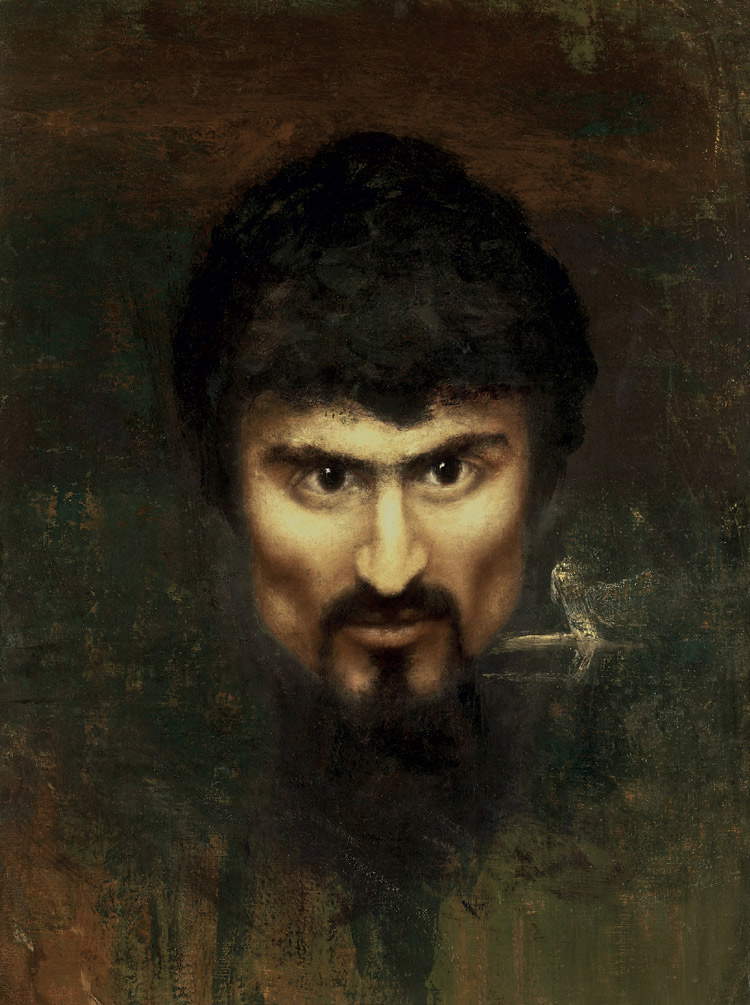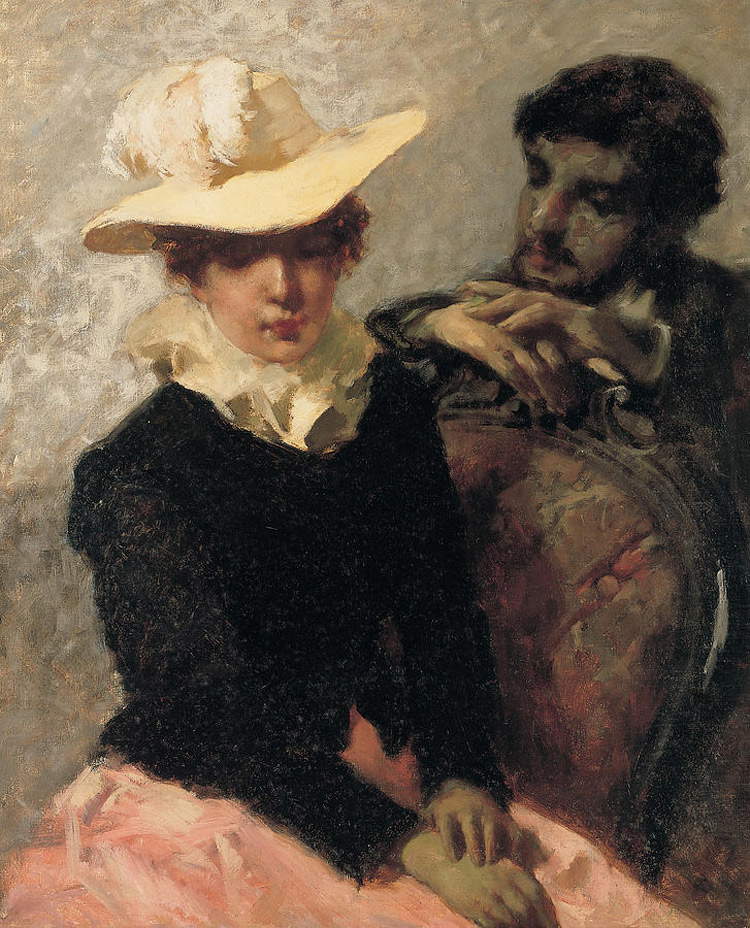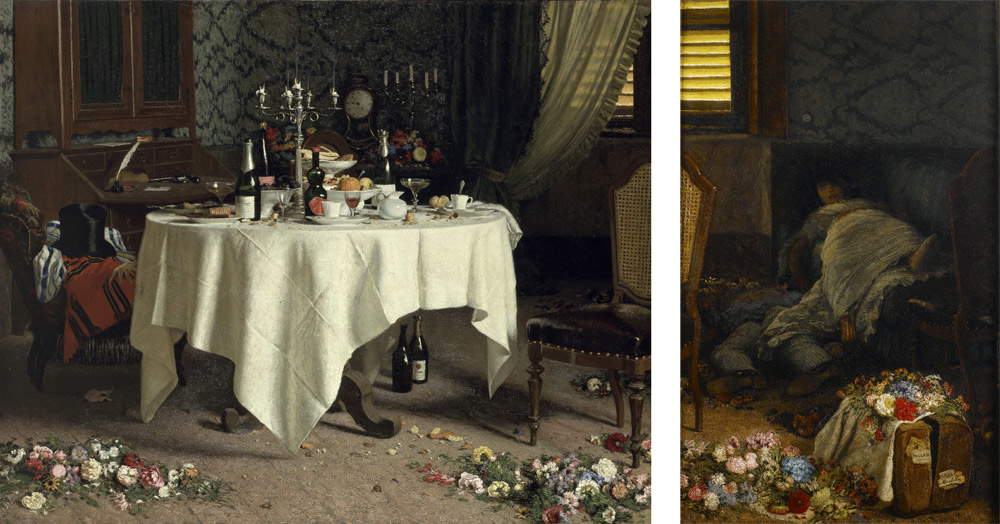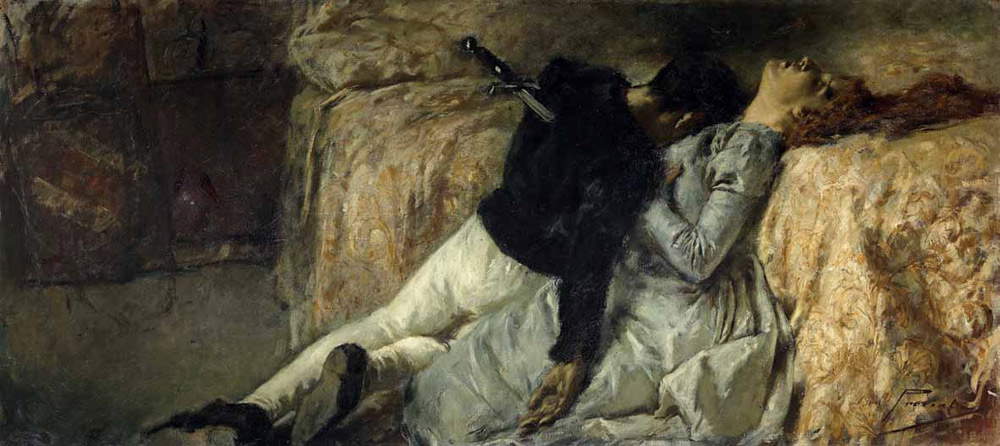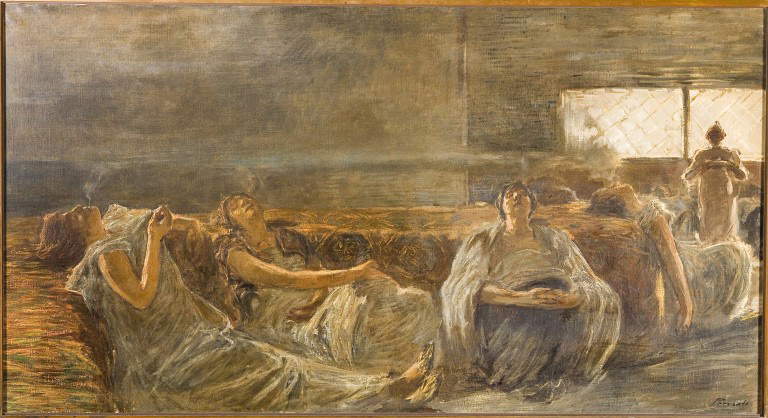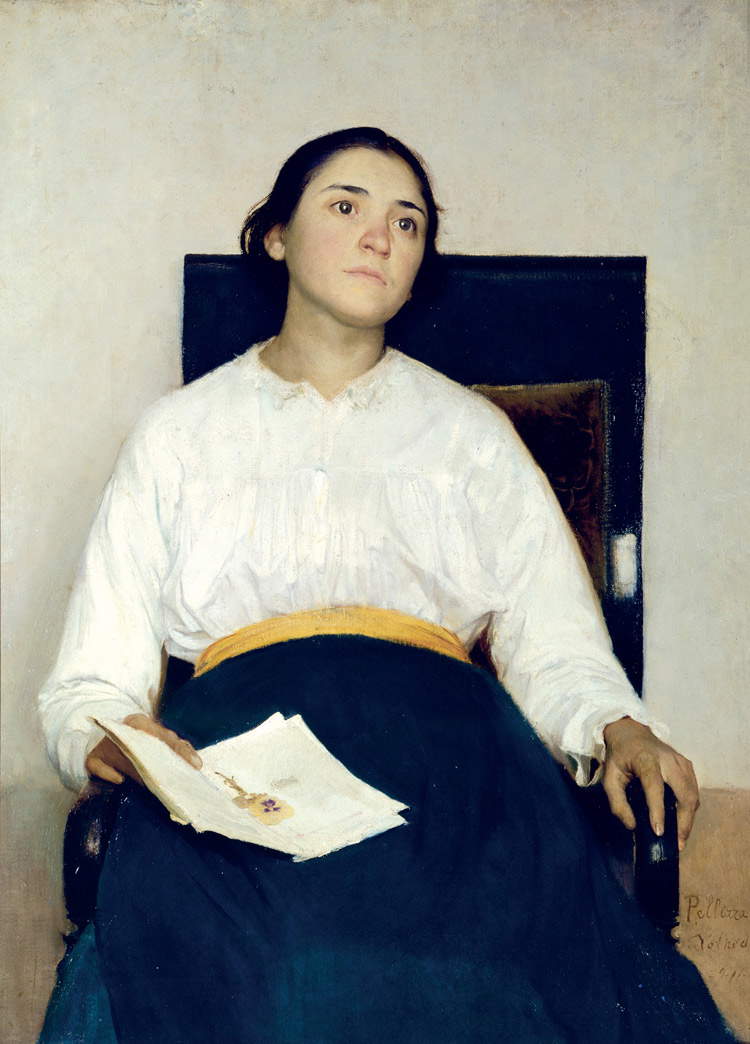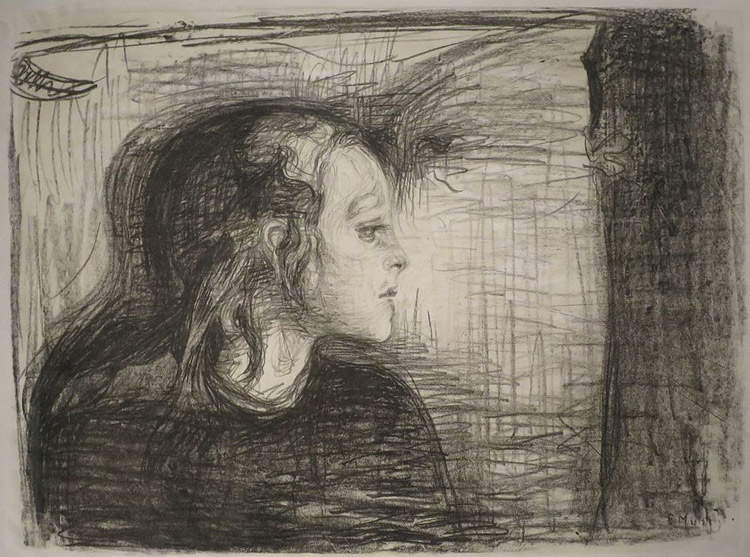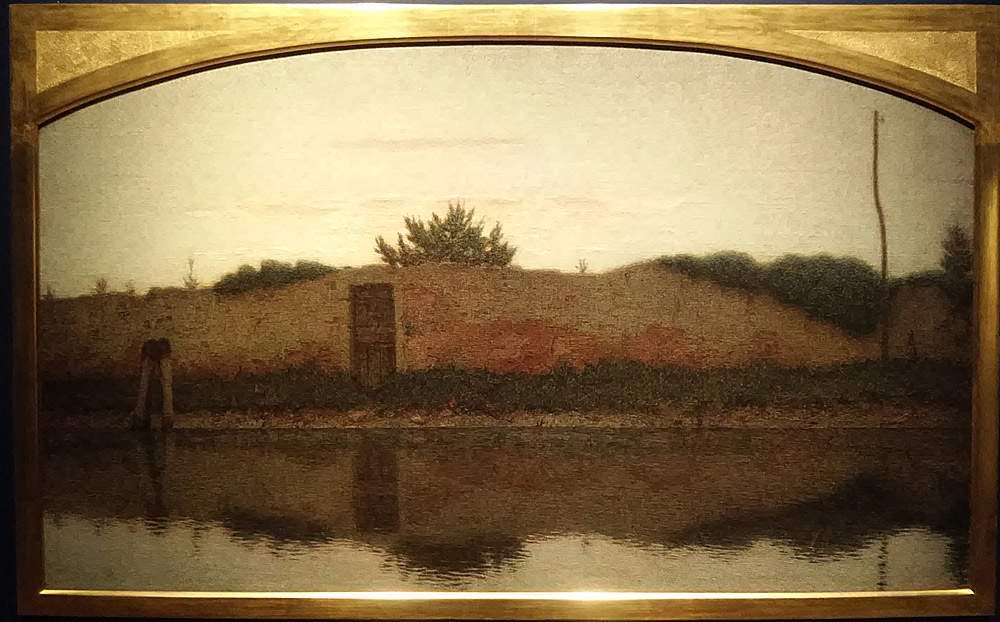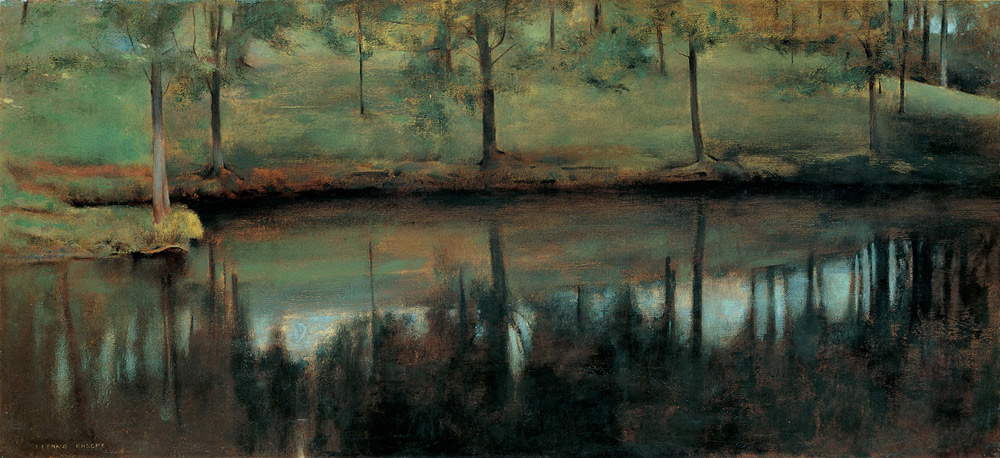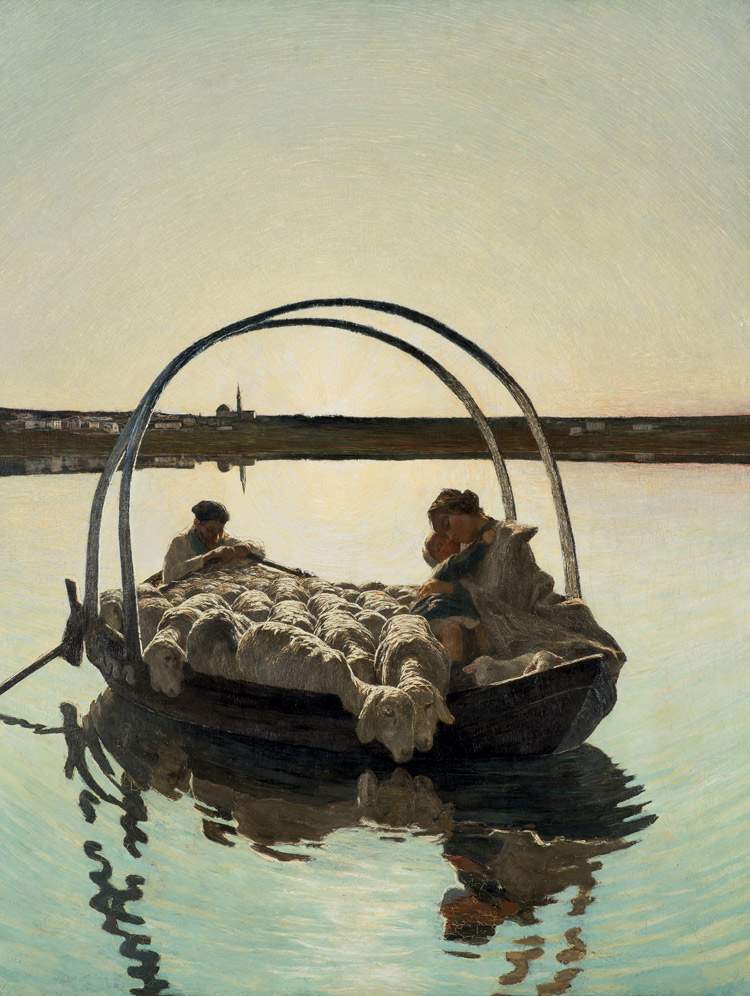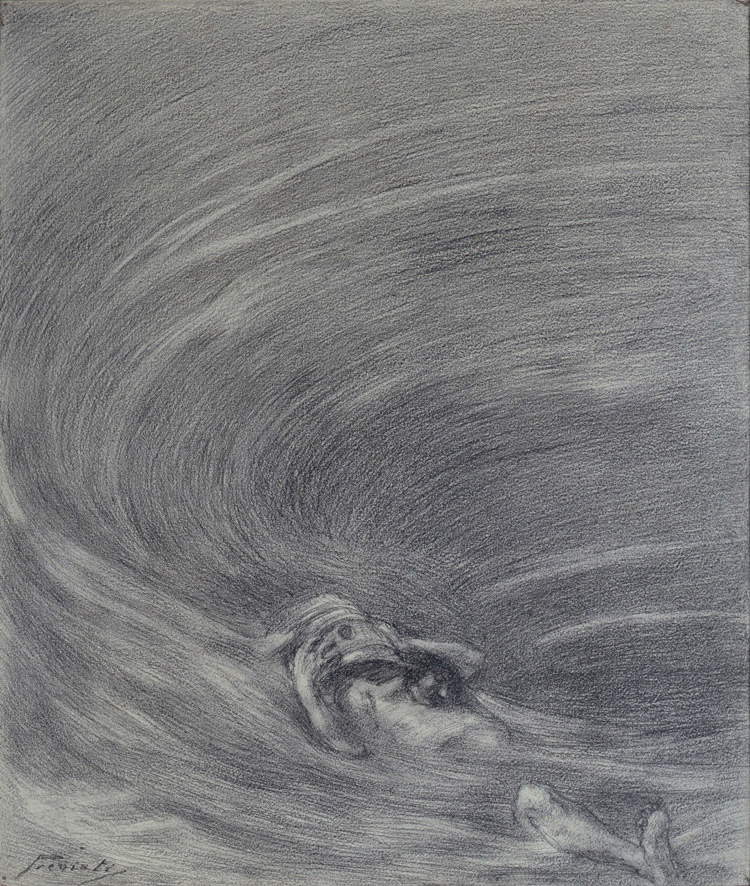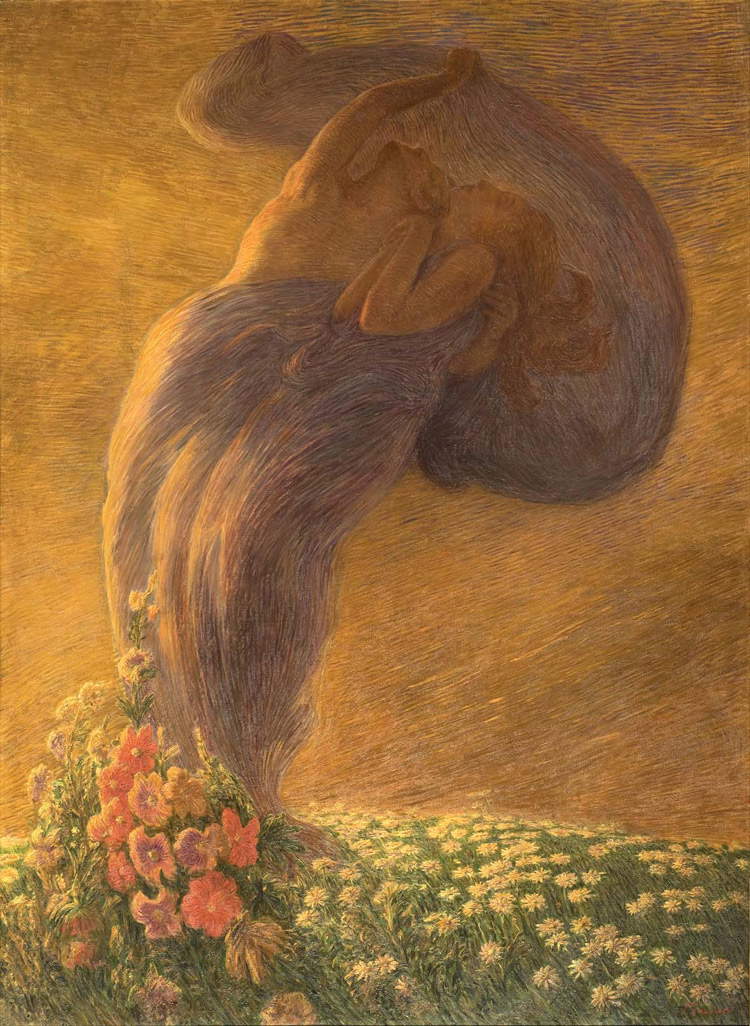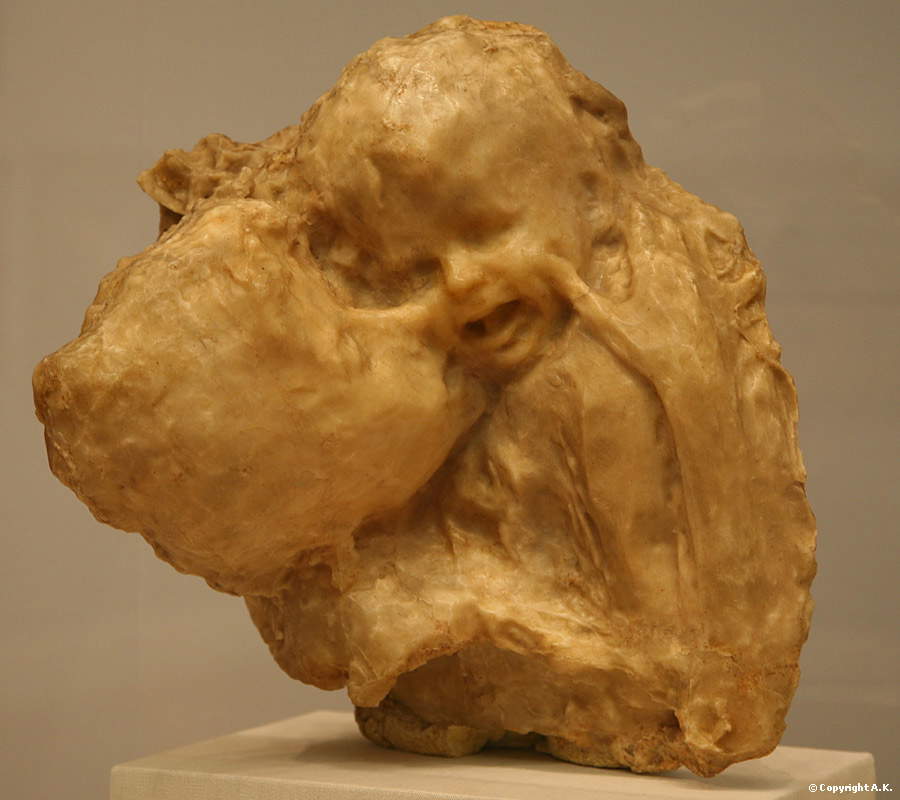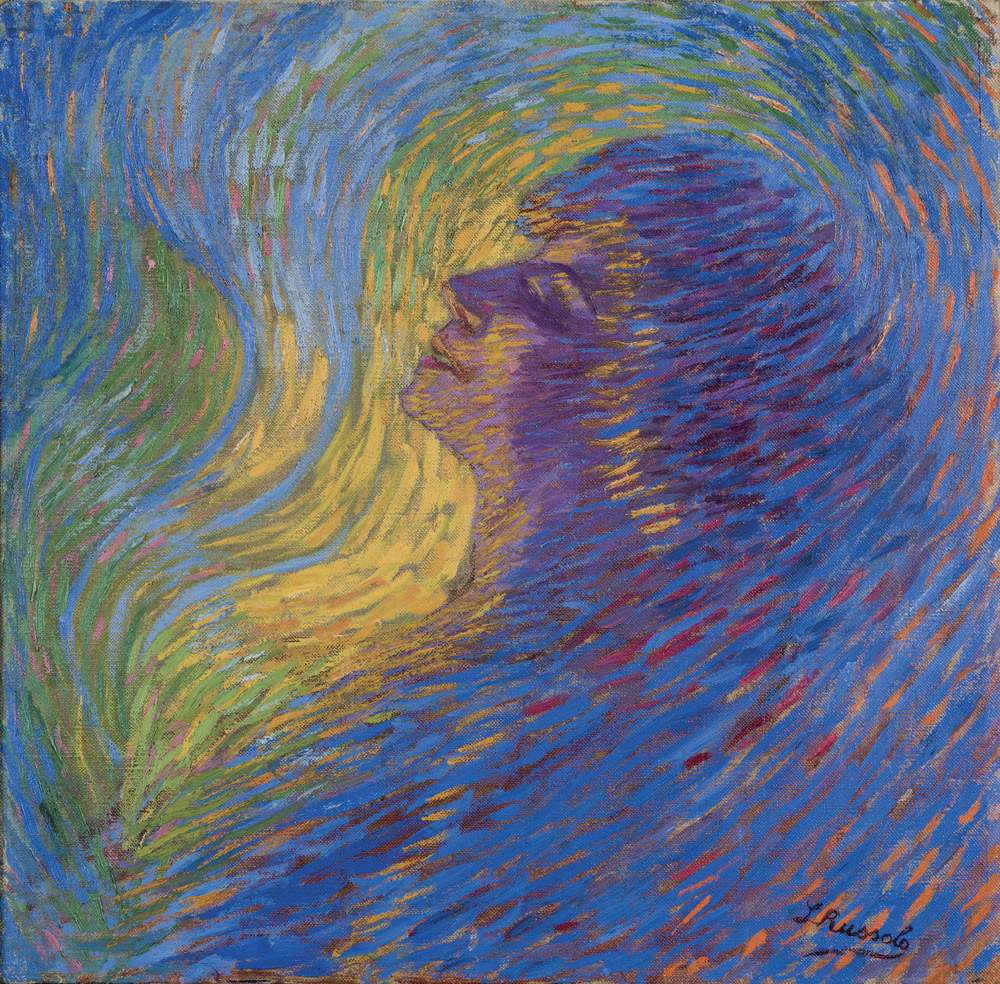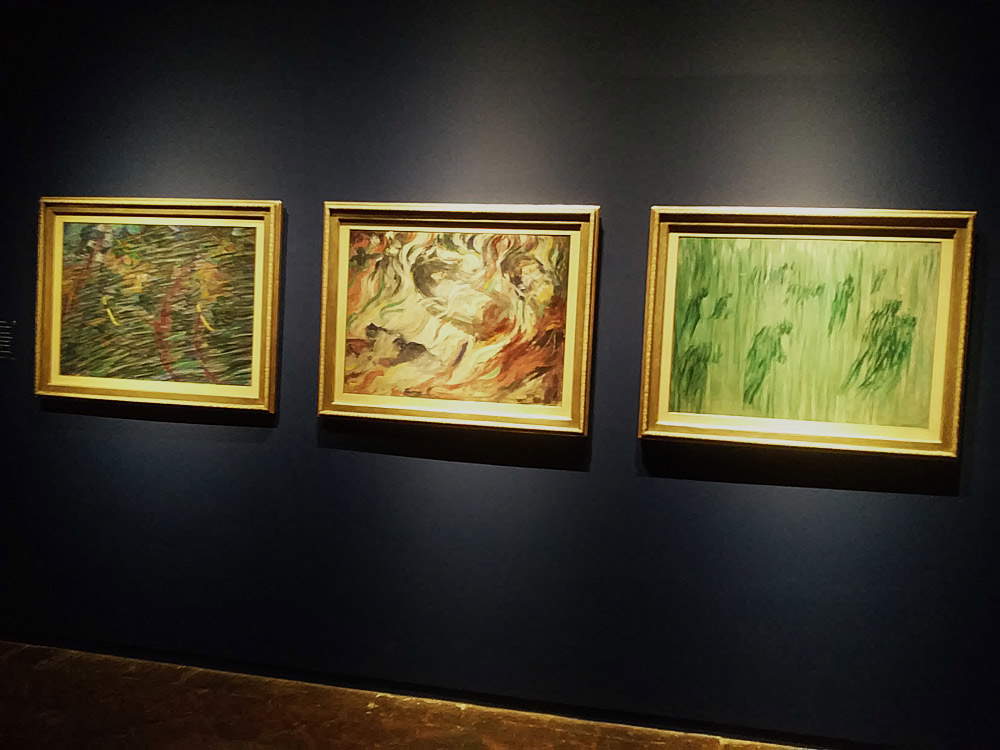by Federico Giannini (Instagram: @federicogiannini1), published on 08/05/2018
Categories: Exhibition reviews
/ Disclaimer
Review of the exhibition 'States of Mind. Art and Psyche between Previati and Boccioni' in Ferrara, Palazzo dei Diamanti, from March 3 to June 10, 2018.
In 1891, when Stéphane Mallarmé found himself in discussion with Jules Huret about the modes and purposes of Symbolist poetry, the great poet told his journalist friend that using a symbol means nothing more than choisir un objet, et en dégager un état d’âme par une série de déchiffrements: “to choose an object, and to develop a state of mind through a series of interpretations.” In other words, according to Mallarmé, poetry had to set itself the precise goal ofevoking an emotion, of stimulating the experience of a certain state of mind and, conversely, of shunning a cold naturalism, guilty of supprimer les trois quarts de la jouissance du poème (“suppressing the three quarters of the enjoyment of a poem”). Poetry, Mallarmé wrote, is a mystery whose key the reader must seek: a reaction against the excess of realism and materialism from which, according to the Symbolists’ beliefs, much of the poetry contemporary to them was affected. And poetry would soon be followed by art as well, eager to offer an alternative to realism and its adherence to truth in order to propose to the relative visions ready to spur his imagination: first by modifying verist painting from within with the addition of elements aimed at presenting the viewer’s eyes with a synaesthetic experience, then by shortening the distance between painter and audience (through an increasingly less precise and, conversely, more smoky and evocative rendering of the painting’s elements), and finally by arriving at an art capable of appealing directly to the moods of those in front of the work.
This, in a nutshell, is also the path outlined, in its historical evolution, by States of Mind. Art and Psyche between Previati and Boccioni, the exhibition on view at Ferrara’s Palazzo dei Diamanti until June 10, 2018. A title entirely consistent with the contents of the exhibition, which puts the spotlight on the figures of Gaetano Previati (Ferrara, 1852 - Lavagna, 1920) and Umberto Boccioni (Reggio Calabria, 1882 - Verona, 1916), the two main poles around which the poetics of states of mind in Italian painting between the late 19th and early 20th centuries revolved. It was Boccioni himself who was the first to systematically declare the intent to experiment with a painting that could provoke an emotional reaction, and it was he who identified Previati as the main explorer of such a disposition: the Ferrara painter, Boccioni had specified during a conference held in Rome in 1911, “is the first person who really tries to express through light a new emotion outside the conventional reproduction of forms and colors. With Previati, Boccioni continued, ”forms begin to speak like music, bodies aspire to become atmosphere, spirit, and the subject is already ready to be transformed into instate of mind." But the thread strung between Previati and Boccioni, at Palazzo dei Diamanti, is populated with a dense theory of additional figures who made the new trends their own and inspected every possibility: the Ferrara review therefore aims to examine the developments of the poetics of states of mind in the art of the time, a topic that is certainly not new (the relationship between Previati and Boccioni just mentioned, moreover, has been widely debated by critics), but here read also through some new contributions (for example, the relationship with the philosophy of Bergson and Sorel, analyzed by a contribution by Michael Zimmermann who goes so far as to draw interesting connections with the actuality of contemporary media, which will be discussed later, or theliterary interests of Giovanni Segantini, whose library was subjected to an unprecedented reconnaissance precisely on the occasion of the exhibition) that provide additional and new cues for reconstructing the complexity of an era of great and dense cultural ferment, from the basis of which futurism would later spring and which represented a fundamental moment of passage for the construction of modernity.
 |
| A room in the exhibition States of Mind. Art and Psyche between Previati and Boccioni |
 |
| A room from the exhibition States of Mind. Art and psyche between Previati and Boccioni |
 |
| A room from the exhibition States of Mind .Art and Psyche between Previati and Boccioni |
Theoverture is entrusted precisely to Giovanni Segantini (Arco, 1858 - Pontresina, 1899), of the Italian painters the closest to the instances of the French Symbolists: his Self-portrait, which sees him depicted with only his head silhouetted against a somber background and his grim gaze penetrating the eyes of those of us who observe him, is a sort of summation of the interests that guided many of the painters of the time. The careful study of expression, facial expressions, muscle movements and all those elements that the artist employs to conduct a thorough psychological investigation of himself, reflect the readings of Charles Darwin’s evolutionary theories that stimulated an in-depth study of physiognomy (“the portrait , Segantini would have written in 1890 in a letter sent to Vittore Grubicy, ”is the study that with the greatest simplicity of means encloses the most effective word of art in the expression of the living form"), while the imperious fixity of the gaze and the ability of Segantini’s face to become an almost hieratic icon are a reflection of the author’s Symbolist impulses. Common to many of the artists of the time is the habit of moving on the thin boundary between science and the irrational, a boundary on which Previati himself would also frequently run, who is presented in the introduction to the exhibition with Aurora of 1884, a portrait of his fiancée where he depicts himself in absorbed and mute contemplation of the beautiful young woman: a painting steeped in the sentimentality that the scapigliati, some years earlier, had begun to make the subject of investigation, and which Previati resolves and brings up to date with a painting that throbs with quivering emotion, with the two protagonists communicating their love with sweet and languid gestures, against an indefinite background that almost transports their passion within a dream dimension.
Three years later, however, is his version of Paolo and Francesca, a painting with a Dante theme that disrupts the historical-literary painting of the time with a new and revolutionary figuration: in an interior with blurred, almost indefinite contours, the two lovers lie pierced by the same sword, Francesca is with her head lying on the couch, agonizing, and Paolo’s body is abandoned on that of his beloved, on his back and disheveled. It is an oppressive and distressing atmosphere, a framing that lingers on the two lovers by catching them from a close distance and that aims to arouse unease in the viewer in a stark and bleak painting, an “acrid autopsy of the romantic myth,” to use an effective expression by Fernando Mazzocca (who curated the exhibition together with Chiara Vorrasi and Maria Grazia Messina) dating back to a study almost two decades ago and which is often called into question when discussing this painting that Previati presented at the 1897 Biennale. A work with which, Chiara Vorrasi points out instead, the author “distances himself from the most recent epigones of history painting to go back to the sources of an art capable of conveying in the most direct and intense way possible affective relationships and emotional states.” Not dissimilar was the approach of Angelo Morbelli (Alessandria, 1854 - Milan, 1919), who three years earlier had shocked the public and critics with his Asfissia!, a chronicle of a dramatic suicide of a couple divided by marked social differences and therefore unable to live with serenity a relationship that we must imagine was strongly opposed by the conventions of the time. The painting, objective and devoid of any moralistic intentions, seeks rather to involve the viewer through the evocation of sensory experiences: Morbelli’s brush focuses on the table with the leftovers of a dinner, on the flowers scattered all over the floor (cut flowers, and therefore a symbol of the unfortunate fate of the two lovers), on the morning light that filters through the shutters revealing little by little the tragedy that took place in the hotel room, with the bodies of the man and the lifeless woman in the background. The work did not have much luck, and Morbelli cut it into two parts to free the right portion, the one where the couple is present, in order to exhibit it alone so that the public could focus more directly on the theme of the story (and even today the two dismembered parts are kept in different collections: the merit of the Ferrara exhibition is also that of having temporarily reunited them). If Morbelli’s closeness to symbolism is consummated above all in the parallelism between flowers and couple, in a painting like Previati’s The Opium Smokers the link appears more stringent: exotic setting, muffled atmosphere, obvious yielding to the poetry of Charles Baudelaire with the evocation of his artificial paradises, but also keen interest in the latest scientific research, since he had been an anthropologist from Brianza, the distinguished Paolo Mantegazza (Monza, 1831 - San Terenzo, 1910), who published a treatise in which he analyzed the effects produced on the body and psyche by the use of narcotic substances such asopium, which is the protagonist of Previati’s painting and whose use was widespread at the time.
 |
| Giovanni Segantini, Self-Portrait (ca. 1882; oil on canvas, 52 x 38.5 cm; Sankt Moritz, Segantini Museum, deposit of the Eidg. Kommission der Gottfried KellerStiftung) |
 |
| Gaetano Previati, Aurora (1884; oil on canvas, 98 x 80 cm; Private collection, courtesy Galleria Bottegantica, Milan) |
 |
| Angelo Morbelli, Asfissia! (1884; Left part: oil on canvas, 159 x 199.5 cm; Turin, GAM, Galleria Civica dArte Moderna e Contemporanea, Fondazione Guido ed Ettore De Fornaris. Right part: oil on canvas, 160 x 98 cm; Private collection) |
 |
| Gaetano Previati, Paolo and Francesca (c. 1887; oil on canvas, 98 x 227 cm; Bergamo, Accademia Carrara) |
 |
| Gaetano Previati, Le fumatrici d’opio (c. 1887; oil on canvas, 80.3 x 149.7 cm; Piacenza, Galleria dArte Moderna Ricci Oddi) |
The prologue of the exhibition thus contains all the elements that, as the exhibition proceeds, guide the viewer to discover the evolving poetics of feelings and states of mind. States of mind that, in the following rooms, the Palazzo dei Diamanti exhibition intends to investigate individually through dedicated sections. The collapse of the nineteenth-century myths “in the face of the inability of liberal society and positivist culture to respond to the salvific promises of bourgeois revolutions, Risorgimento ideologies or the myth of scientific and technological progress” (Chiara Vorrasi puts it this way) produced real spiritual rubble that fell on society, arousing unease and malaise (the aforementioned Mantegazza, moreover, would rename the nineteenth century “the neurotic century”). And also from such premises arises that need, which developed hand in hand with the birth of disciplines such as psychoanalysis and phrenology, that drives artists to delve into the innermost spheres of the human soul. A clear image of such a malaise is the Ricordo di un dolore by Giuseppe Pellizza da Vol pedo (Volpedo, 1868 - 1907): the artist recalled, in a letter written to Vittorio Pica, how he had been “struck by the death of a sister” (the very young Antonietta, who died at only eighteen), which is why he wanted to fix his grief on canvas with a “half-figure” that deals with the theme of melancholy with poignant strength. A melancholy that is here expressed by the protagonist’s dismayed and lost in the void gaze, evidently reached by bad news such as that which had so deeply marked the painter, who had a difficult existence marked by serious mourning, so much so that it was Pellizza himself who decided to end it prematurely, at only thirty-nine years of age. Edvard Munch ’s (Løten, 1863 - Oslo, 1944) feelings were also greatly affected by the vicissitudes of his sister, who was sick with consumption, and whose suffering seems almost to be narrated in The Sick Child, a childish portrait in which the protagonist turns her lost and tormented gaze toward the landscape.
It is precisely the landscape that becomes the protagonist of the next section, and Munch’s Sick Child, which also serves as a viaticum for the following room, guarantees one of the most intense passages in the exhibition. That late nineteenth-century art, following the theories of Swiss philosopher Henri-Frédéric Amiel (Geneva, 1821 - 1881), author of the famous formula un paysage est un état de l’âme (“a landscape is a state of mind”), tended to identify a given mental disposition in a landscape is certainly not a discovery of the Ferrara exhibition, but the selection on the theme of the landscape-state of mind is particularly rich and summarizes very well both the arguments of the Symbolists and those of the Divisionists. For the former, the element of water plays a primary role: calm surfaces reflect objects that lie outside our view, so as to present the viewer with a kind of invitation to inner reflection, as is the case withCalm Water by the Belgian Fernand Khnopff (Grembergen-lez-Termonde, 1858 Brussels, November 12, 1921). For the latter, on the other hand, the assumption of arousing a memory or sensation in the soul of the subject applies: the example of the painting Era già l’ora che volge il desio by Morbelli, who described his work with the Dantesque title as a “nostalgia of dead things, a sunset on the desolate shores of Venice, a Burano canal,” is worth mentioning. In the middle is Segantini, who is present in this section with a masterpiece such asAve Maria a trasbordo, perhaps the first true Divisionist painting: what appears to be a placid genre scene, with a shepherd in the company of his wife carrying sheep from one shore of a mountain lake to the other (a scene in which the decomposition of color masterfully renders the effect of the water reflecting the shepherd’s boat), on the one hand, with its peaceful panism sends us back to a dimension of universal harmony in which man enters into perfect harmony with nature, and on the other hand, it implies symbolic meanings that make clear the convictions of the painter, who was sure of the “omnipresence of the divine in nature,” so that “the believer no longer needs the church as a place of worship” (thus Mirella Carbone). The church, in fact, is a distant presence, and the protagonists prefer to pray directly on their boat, under the trees that look almost like the arches of the vault of a house of worship.
Past the section devoted to the evocative functions of music (Previati’s Moonlight, a sort of landscape of the soul where night no longer has a descriptive function, is not to be missed) we reach the center of the exhibition, where we find exhibited the great and difficult Maternity, a masterpiece with which Previati intended to convey “all the intensity of maternal love,” as he wrote in a letter to his brother, and which he exhibited for the first time at the Brera Triennale of 1891 and with which he inaugurated the most strictly Divisionist season of his career. The Ferrara painter’s idea was as revolutionary as it was dangerous: to revisit profoundly a classic theme of tradition (the nativity) in both technical and symbolic respects. The artist was perfectly aware of the risks to which he would subject himself: nevertheless, the judgments of critics and the public were very severe, and in some cases bordered on insult. Few, including Vittore Grubicy, sensed the innovative and original scope of the work, whose intent was, Fernando Mazzocca explains, to “represent the deepest drives of the human soul and the unfathomable mystery of motherhood, of creation.” Thus having to probe the unfathomable, painting loses all realistic or naturalistic accents and becomes pure vision, in line, moreover, with what was happening even outside Italy (think of Gauguin’s art). Radically different is Segantini’s approach, who does not renounce a truthful representation, but cloaks his descriptions with a strong allegorical sense, as occurs in The Angel of Life which, unlike Previati’s Maternity, was immediately successful because it was able to propose the paradigm of a realism capable of surpassing reality: a mother embraces her child above the branches of a tree in a mountain landscape, of those so beloved by Segantini, sanctioning, with its halo of intense spirituality, the triumph, beauty and wonder of life, as well as its mystery. Two radically different approaches, the central room offers the visitor one of the most exhilarating passages in the entire exhibition.
 |
| Giuseppe Pellizza da Volpedo, Ricordo di un dolore(Portrait of Santina Negri) (1889; oil on canvas, 107 x 81 cm; Bergamo, Accademia Carrara) |
 |
| Edvard Munch, Sick Child I (1896; color lithograph with lithographic crayon, ink and needle, sheet: 477 x 625 mm; engraved: 475 x 611 mm; Vienna, Albertina Museum) |
 |
| Angelo Morbelli, Era già l’ora che volge il desio (1910-13; oil on canvas, 104 x 175 cm; Private collection, courtesy Studio Paul Nicholls) |
 |
| Fernand Khnopff, Still Water (1894; oil on canvas, 53.5 x 114.5 cm; Vienna, Belvedere) |
 |
| Giovanni Segantini, Ave Maria at Transshipment (second version, 1886; oil on canvas, 120 x 93 cm; Sankt Moritz, Segantini Museum, repository of the Otto Fischbacher-Giovanni Segantini Stiftung) |
 |
| Gaetano Previati, Maternity (1890-91; oil on canvas, 175.5 x 412 cm; Banco BPM Collection) |
 |
| Giovanni Segantini, The Angel of Life (1894; oil on canvas, 276 x 212 cm; Milan, Galleria dArte Moderna) |
The journey into the human soul followed with a descent into the abysses of fear: scouring the human psyche also meant traversing its most horrific and gloomy aspects, and many painters, inspired also by the numerous literary works that dealt with the theme of the nightmare, attempted to flesh out such suggestions. The undisputed protagonist of the literature of terror was Edgar Allan Poe (Boston, 1809 Baltimore, 1849), and in Italy various artists wanted to illustrate his stories, beginning with Previati himself, who produced a series of drawings directly inspired by the American writer’s tales: the Descent into the Maëlstrom stands out above all, where the swirling sea that sucks in the Norwegian sailors who are the protagonists of the novella of the same name extends far beyond the physical limits imposed by the sheet and, below, is lost in a dark depth, expanding the observer’s dismay. Alberto Martini (Oderzo, 1876 - Milan, 1954) also did not fail to grapple with Poe’s tales: his Raven is the horrifying shadow of the eerie bird that seems to take shape from a nightmare. Closely related to the theme of fear are the impulses triggered by voluptuousness andferal instincts, consequences of the change in customs (including sexual habits) that characterized life in the big cities of the time. Prominent then are Franz von Stuck’s (Tettenweis, 1863 - Munich, 1928) celebrated Sin, one of the most iconic and terrifying depictions of the topos of the femme fatale that was then beginning to make its way into artists’ imaginations, and Previati’s Cleopatra, forerunner of the decadent hero, who redeems her own debauchery with death. The rise to more radiant passions begins with ecstatic rapture, which, stripped of all mystical or religious references, becomes synonymous with a pure, overwhelming and eternal passion, sublimated in luminous dreamlike visions such as Previati’s Dream, and finally reaches the states of solarity andenthusiasm: the lightness of the latter is rendered mainly through a new representation of light, suggested by familiarity with the theories of Charles Henry, who thought there was a correlation between the structure of an image and its ability to arouse pleasurable sensations, or with the psychophysiology of Hermann von Helmholtz, to whom we owe studies on the sensations induced by light exposure. Significant in this sense is a masterpiece such as Previati’s Dance of the Hours, where “the impalpable texture of the filamentous brushstrokes and the chromatic range harmonized on a few luminous tones achieve effects of permeability and dynamic lightness such as to cancel the physicality of the figures and celestial bodies” (Chiara Vorrasi).
The rapid journey into the twentieth century is addressed in theepilogue of the review: artists of the new generation are increasingly convinced that the force of emotions must be the true subject of a painting or sculpture, and consequently they believe that painting or sculpting a subject does not mean providing the observer with a faithful portrait of it, but “making the atmosphere of it,” as the 1914 Manifesto of Futurism states, where we also read that “the portrait, to be a work of art, cannot and must not resemble its model, and that the painter has in himself the landscapes he wants to produce.” An important intermediary is Medardo Rosso (Turin, 1858 - Milan, 1928) who, admired also for his experimental uses of photography, with his studies of the affections (see his Aetas aurea of 1886, a portrait of his wife Giuditta and son Francesco) opens up to the investigation of human relationships by Giacomo Balla (Turin, 1871 - Rome, 1958), who in his Affetti renders all the intimacy of an intense moment between mother and daughter, and to those of Umberto Boccioni.
It was Boccioni who was credited with updating the poetics of moods to project it into the frenzy of industrial society. The Futurist manifesto had definitively sanctioned the total detachment of art from tangible reality, putting in writing a trend that younger artists had already begun to make their own: Luigi Russolo ’s Perfume (Portogruaro, 1885 - Laveno-Mombello, 1947), from 1910, with its colorful swirl broken up into dense, short, multicolored brushstrokes, arouses vivid olfactory sensations, while Carlo Carrà ’s Milan Station (Quargnento, 1881 - Milan, 1966), a year later, transports the viewer into the midst of the fumes, noise, noisy buzz, crowds and dynamism of a modern metropolis, without directly representing the Milanese station, but evoking its atmosphere. Boccioni, as pointed out at the beginning, had found in Previati his most direct antecedent, as an artist who had set himself the problem of overcoming the most rigid mimesis in favor of a painting capable of becoming a sensation: here, then, is the first version of the States of Mind triptych, composed of three canvases, Quelli che vanno, Gli addii, and Quelli che restano, which leave pointillism behind by focusing on a figuration in which protagonists and setting are now inextricably fused with the atmosphere and where light and color take on the burden of expressing the sadness of a farewell to the station. The farewells, at the center of the triptych, with their curved lines evoke the embraces between those who will soon part. Those who go are lost among the thick, horizontal brushstrokes that suggest their departure, perhaps never to return. Those who remain, on the other hand, are despondent shadows, stooped by the torment of separation, and proceeding at a slow pace amidst a sad haze that envelops all. Painting that produces immediate emotional effects, as per the programmatic goal of the Futurists. Painting that, Michael Zimmermann has noted, also tries to surpass the newly born cinema, since it assumes a choral point of view and urges the viewer to identify with the various protagonists of the work. Painting that aspires to make manifest the Futurist belief that “the true revolutionary force was identified in a widespread collective affectivity” (Zimmermann) and to make the viewer fully participate and empathize with the protagonists. Painting that, in other words, investigates the psychic manifestations of an undistinguished crowd caused by a given event and that therefore, in some ways, according to the German art historian, anticipates in some ways the modes of socialization induced by social media.
 |
| Gaetano Previati, Descent into the Maëlstrom (1888-1890; black charcoal on paper, 315 x 380 mm; Private collection) |
 |
| Alberto Martini, The Raven (1906; India ink on cardboard, 360 x 250 mm; Private collection) |
 |
| Franz von Stuck, The Sin (1909; oil on canvas, 88.5 x 53.5 cm; Palermo, Galleria dArte Moderna Empedocle Restivo) |
 |
| Gaetano Previati, Cleopatra (1903; oil on canvas, 165 x 145 cm; Private collection) |
 |
| Gaetano Previati, The Dream (1912; oil on canvas, 225 x 165 cm; Private collection) |
 |
| Gaetano Previati, The Dance of the Hours (ca. 1899; oil and tempera on canvas, 134 x 200 cm; Milan, Fondazione Cariplo Collection, Gallerie d’Italia Piazza Scala) |
 |
| Medardo Rosso, Aetas aurea (1886; wax on plaster, 50 x 48 x 35 cm; Lugano/London, Amedeo Porro Fine Arts) |
 |
| Giacomo Balla, Affects (1910; oil on canvas, 115 x 71.5, 115 x 129.5, 115 x 71.5 cm; Rome, Galleria Nazionale dArte Moderna e Contemporanea) |
 |
| Luigi Russolo, Profumo (1910; oil on canvas, 65.5 X 67.5 cm; Rovereto, Mart, Museo di arte moderna e contemporanea di Trento e Rovereto, VAF-Stiftung Collection) |
 |
| Umberto Boccioni, States of Mindtriptych |
 |
| Umberto Boccioni, States of Mind I: The Farewells (1911; oil on canvas, 71 x 96 cm; Milan, Museo del Novecento) |
 |
| Umberto Boccioni, States of Mind I: Those Who Go (1911; oil on canvas, 71 x 95.5 cm; Milan, Museo del Novecento) |
 |
| Umberto Boccioni, States of Mind I: Those Who Remain (1911; oil on canvas, 71 x 96 cm; Milan, Museo del Novecento) |
Boccioni’s works come to bid farewell to visitors at the end of a long, surprising and exciting descent into the human psyche that is sure to be compelling: the transitions from one section to the next are gradual and linked together with clarity and coherence, the introduction and epilogue provide an indispensable contextualization underscored, in all the rooms, by the layouts that refer to constant parallels between art, technological progress and scientific research of the time (as well as, albeit to a lesser extent, with the orientations of criticism between the late nineteenth and early twentieth centuries), the selection of works to illustrate the various sentiments is of sublime quality and particularly effective not only in serving as an illustration of this sort of grand compendium of human feelings synthesized by States of Mind, but also in marking an art-historical course (the time is that of the transition from Symbolism to Pointillism and from Pointillism to Futurism) of a high standard.
One cannot help but notice how the exhibition seeks to affirm the centrality of the figures of Previati and Boccioni: a centrality reaffirmed by the ample space also reserved in the catalog for these two great geniuses of Italian art history. As for the catalog, it unfortunately touches to point out the lack of worksheets, compensated, however, by some focused insights on a selection of the main masterpieces, long thematic insights by Chiara Vorrasi (which also serve as a punctual guide through all the works on display), a very substantial and indispensable chronology that combines art, art criticism, science, literature, journalism, music, theater and much more, compiled by Monica Vinardi and Maria Grazia Messina, as well as a body of thorough and consistent essays. Of particular note are Michael Zimmermann’s contribution mentioned in part above, Fernando Mazzocca’s (a dense reconstruction of Previati’s artistic journey) and Monica Vinardi’s, which focuses on Segantini’s literary interests. Many other themes would also be worthy of interest, to which, however, no mention has been made here: Stati d’animo must also be given the merit of having been able to deal with a very complex and articulated subject with a lively path that does not omit important details, that makes comparisons between works and often refers to the European context, that puts together a large number of works that are never out of place in scanning the stages of an intense journey through emotions.
Warning: the translation into English of the original Italian article was created using automatic tools.
We undertake to review all articles, but we do not guarantee the total absence of inaccuracies in the translation due to the program. You can
find the original by clicking on the ITA button. If you find any mistake,please contact us.
